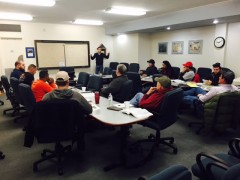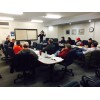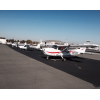PRIVATE PILOT TRAINING – OVERVIEW
When you have your Private Pilot License, you’ll be able to fly friends and family on trips around the country or even internationally. Typically you’ll fly a rented four or six seat airplane that flies at speeds in the 130 to 250 mph range. You might decide to own your own airplane, though most pilots do not. You’ll have access to over 3000 airports around the country and over 5000 airports around the world and will be able to take trips on a weekend that would otherwise require days of travelling by car. Perhaps most important, though, you’ll have the freedom of the skies, able to take off and enjoy the breathtaking scenery and freedom of the skies whenever you choose. You’ll also have set yourself apart from the majority of the population, mastered a great challenge, experienced probably the greatest adventure of all, and have become one of the few who master the skies.
PRIVATE PILOT – TRAINING REQUIREMENTS
To become a Private Pilot typically involves between 35 and 65 hours of flight time, some ground training with an instructor, and you must pass two tests. The FAA regulations requires that you must have at least 35 flight hours if you train at a CFR141 Certified school, but passing in such a short time is fairly unusual; the average is around 65 hours. You might spend anywher from a few weeks to a year to obtain the license depending on your other commitments and time available for training. Most of your flight hours will be with an instructor, but part-way through your training, you will start to fly solo, entirely by yourself. The first solo flight is a great event in every pilot’s career, regardless of whether that pilot becomes a military, airline, or other professional, or just flies for fun.
The tests are carefully controlled for fairness and consistency, and if you’re a safe and competent pilot, properly prepared by your instructor, you should pass easily. One test is a computer based multiple choice format , while the other is a practical test with an examiner, often called the “checkride.” In the practical test, your examiner will ask you oral questions, and then take you flying to determine if your skills are up to the required standards.
PRIVATE PILOT LICENSE – TRAINING COSTS
The cost of obtaining your Private Pilot License is made up of airplane rental, instructor time, books, study materials, pilot supplies, and the test fees. Obviously the final cost depends heavily on how many lessons you need before you’re ready to take the tests. Another significant variable is the airplane you decide to fly while learning. Many people choose to fly a Cessna 172 while they’re pursuing a Private Pilot license, and that will typically cost $120~$145 per hour to rent. If you’re light and not too tall (perhaps less than 170 lbs and under 6′ tall you might choose to fly the Cessna 150 or 152 instead, which is a little cheaper). We also provide training in a modern sport plane called the Remos GX, with digital glass cockpit. Expect your instructor fees in the region of $40 t0 55/hour, for instruction . You can minimize the costs of “ground school” by studying the bookwork by yourself as much as possible and turning up to each lesson well prepared.
For a reasonably realistic working budget you should consider airplane and instructor time, add perhaps $450 for books and materials, another $150~$300 for a headset (you’ll probably want your own) and charts, and about $500 for the exam fees. The costs are spread over the time you take to complete your license. Look at this as a journey, rather than a single achievement, as you’ll presumably want to continue flying after you have been awarded your pilot certificate. Some lenders offer financing for flight instruction, though this varies with the economic climate. Notably, if you’re a Veteran, your benefits can be used for some aspects of flight training.






